【实例简介】拉斐尔·冈萨雷斯,理查德·伍兹 - 数字图像处理(2007年,皮尔逊)
Rafael C. Gonzalez, Richard E. Woods - Digital Image Processing (2007, Pearson)
【实例截图】
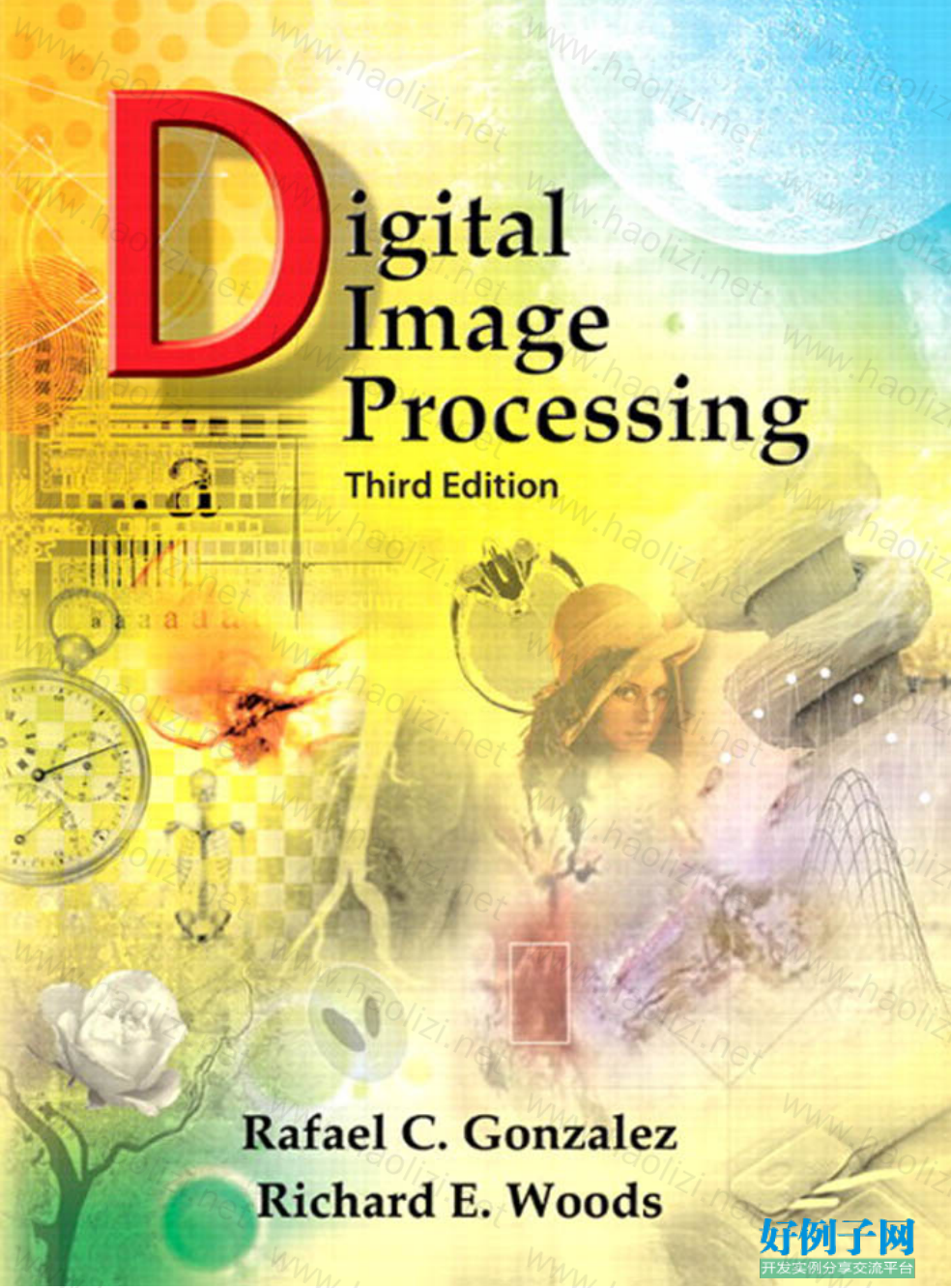
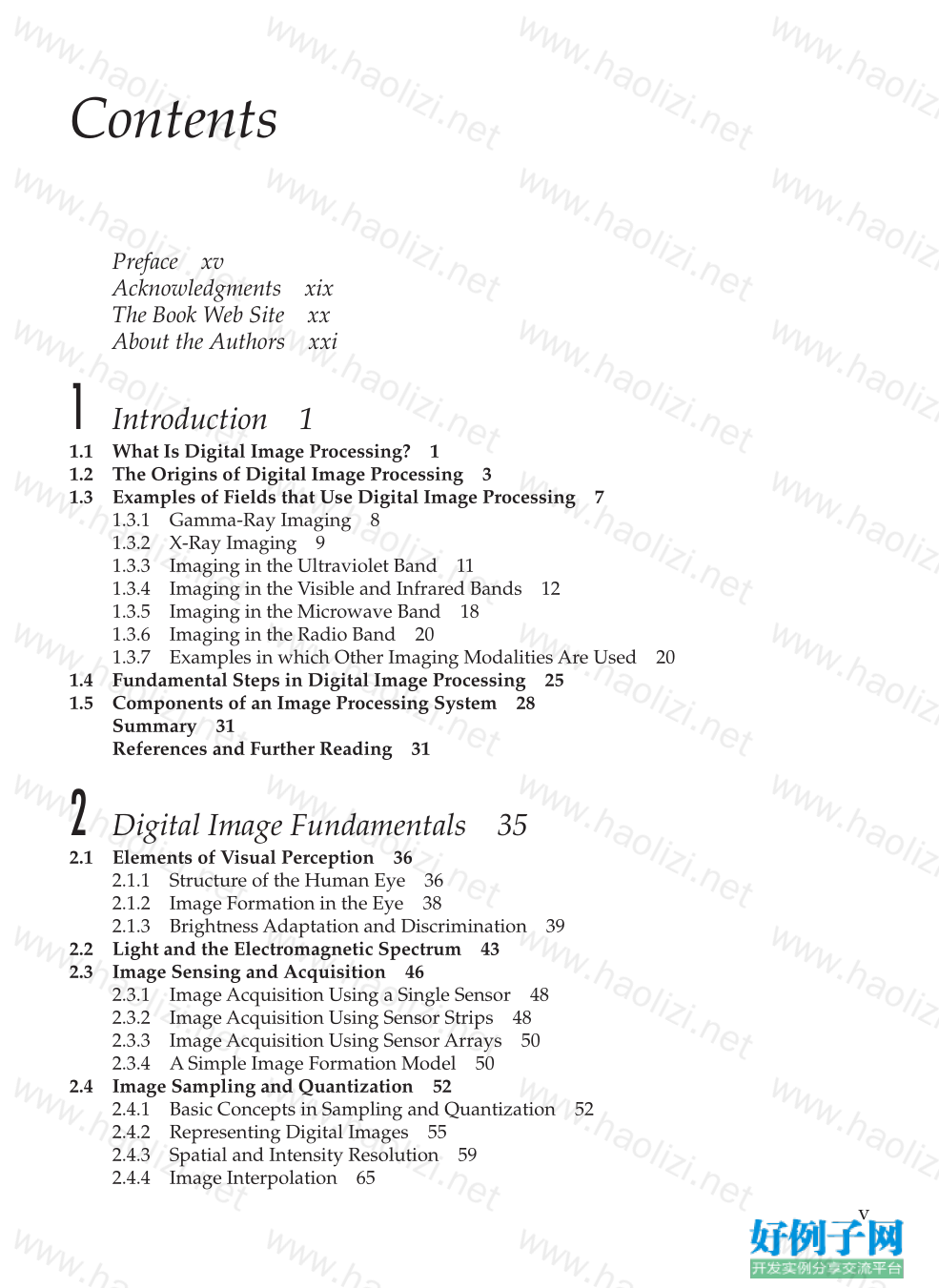


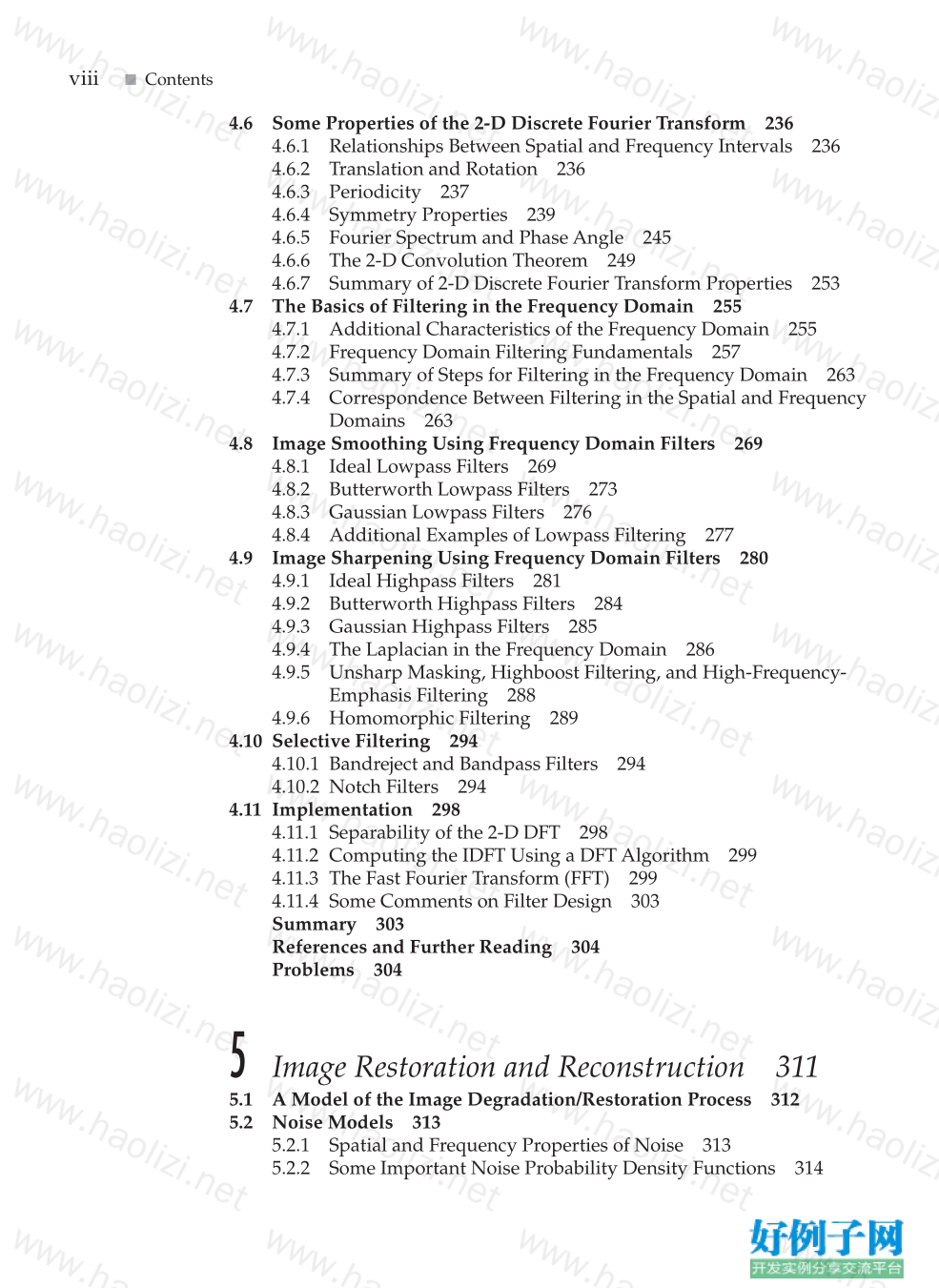

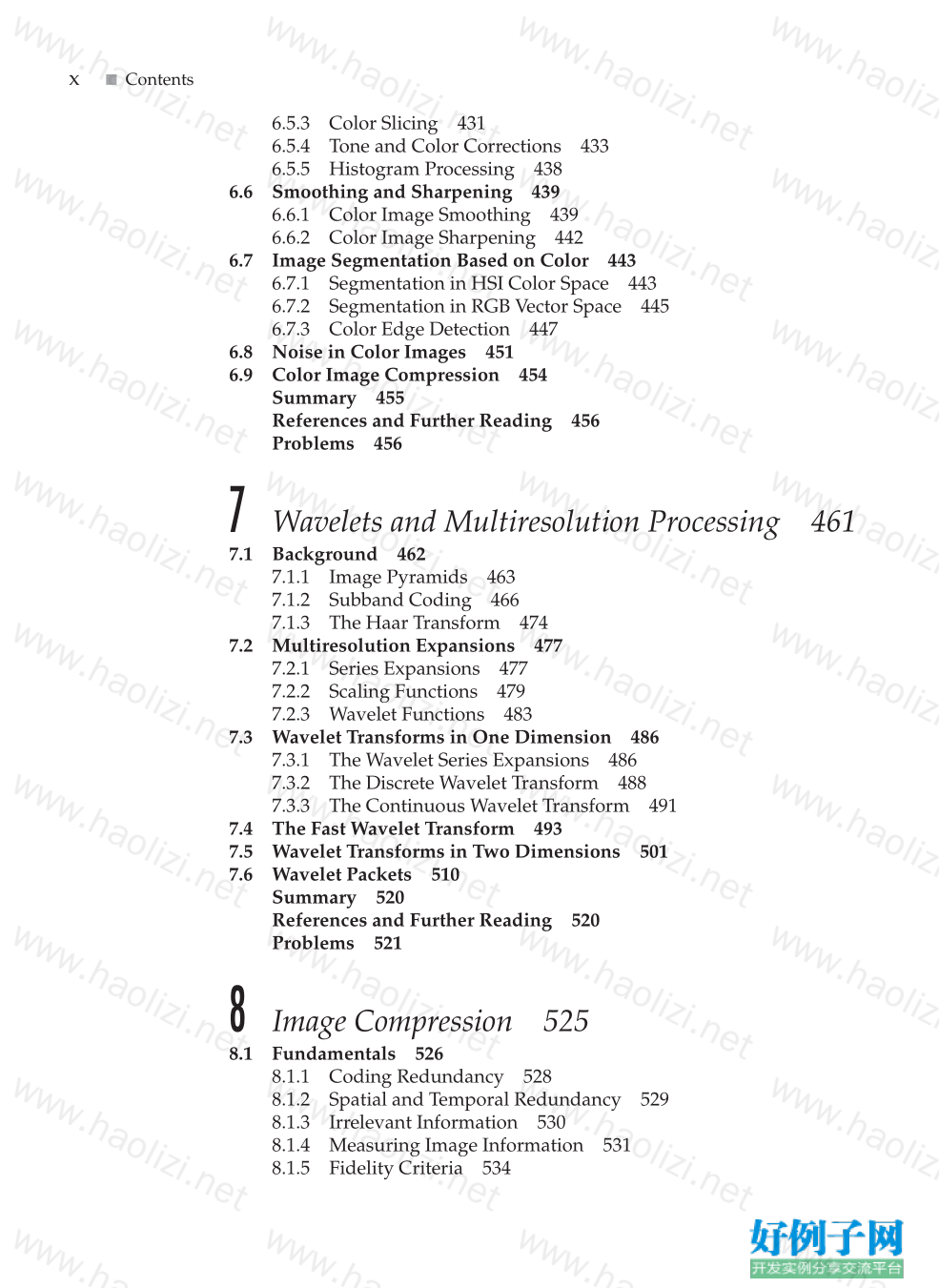

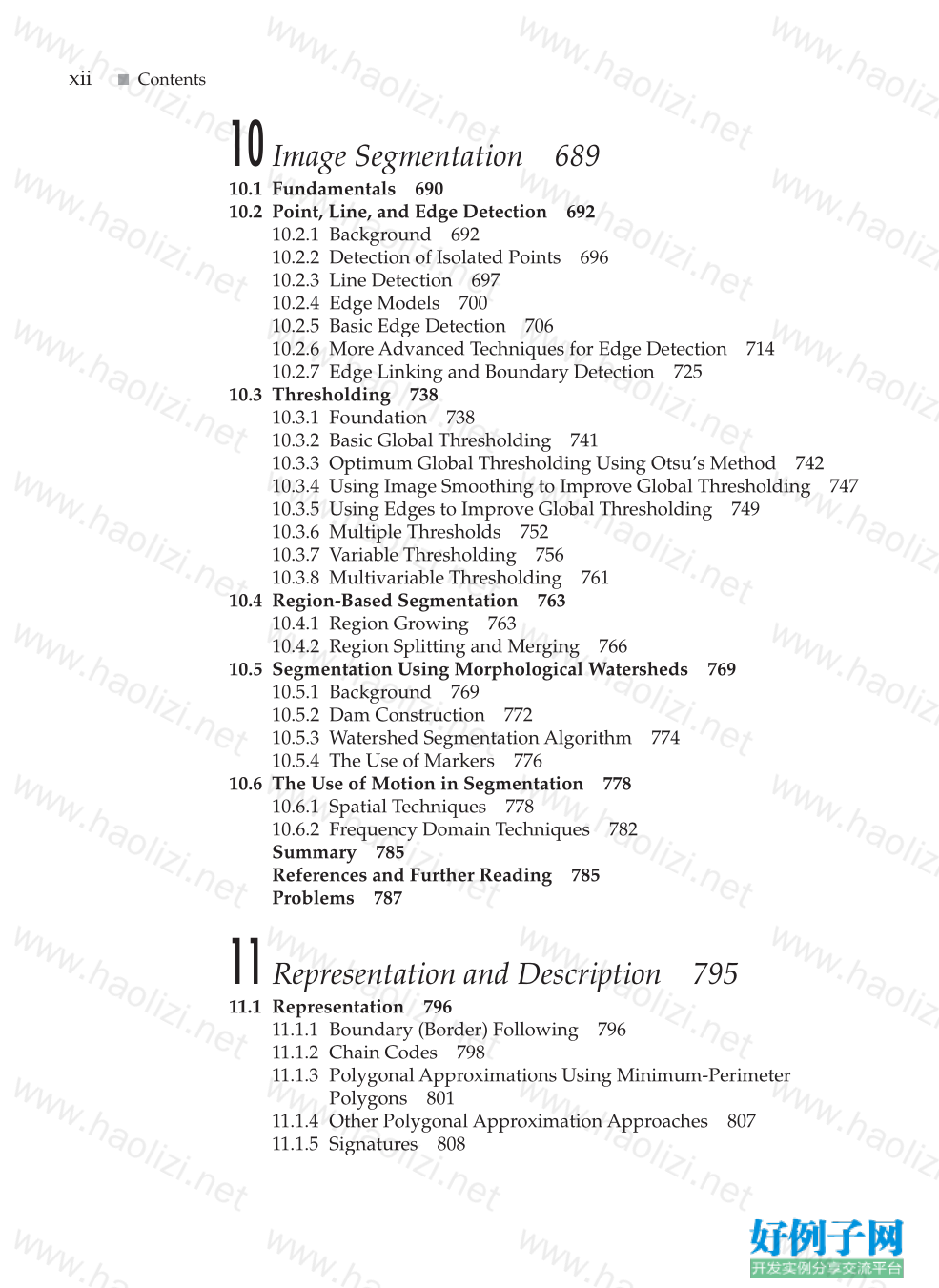
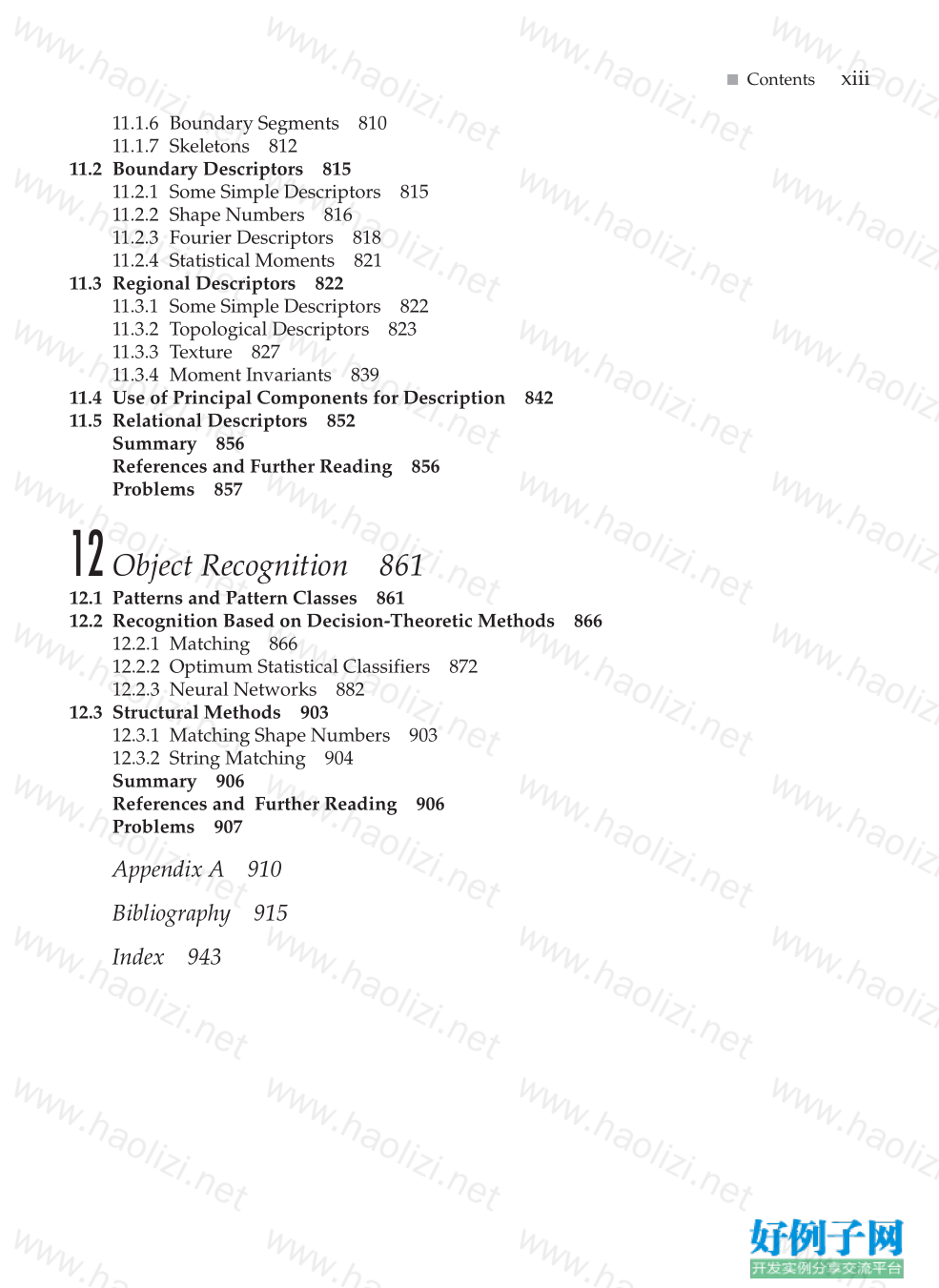
【核心代码】
Contents
Preface xv
Acknowledgments xix
The Book Web Site xx
About the Authors xxi
1 Introduction 1
1.1 What Is Digital Image Processing? 1
1.2 The Origins of Digital Image Processing 3
1.3 Examples of Fields that Use Digital Image Processing 7
1.3.1 Gamma-Ray Imaging 8
1.3.2 X-Ray Imaging 9
1.3.3 Imaging in the Ultraviolet Band 11
1.3.4 Imaging in the Visible and Infrared Bands 12
1.3.5 Imaging in the Microwave Band 18
1.3.6 Imaging in the Radio Band 20
1.3.7 Examples in which Other Imaging Modalities Are Used 20
1.4 Fundamental Steps in Digital Image Processing 25
1.5 Components of an Image Processing System 28
Summary 31
References and Further Reading 31
2 Digital Image Fundamentals 35
2.1 Elements of Visual Perception 36
2.1.1 Structure of the Human Eye 36
2.1.2 Image Formation in the Eye 38
2.1.3 Brightness Adaptation and Discrimination 39
2.2 Light and the Electromagnetic Spectrum 43
2.3 Image Sensing and Acquisition 46
2.3.1 Image Acquisition Using a Single Sensor 48
2.3.2 Image Acquisition Using Sensor Strips 48
2.3.3 Image Acquisition Using Sensor Arrays 50
2.3.4 A Simple Image Formation Model 50
2.4 Image Sampling and Quantization 52
2.4.1 Basic Concepts in Sampling and Quantization 52
2.4.2 Representing Digital Images 55
2.4.3 Spatial and Intensity Resolution 59
2.4.4 Image Interpolation 65
vvi
■ Contents
2.5 Some Basic Relationships between Pixels 68
2.5.1 Neighbors of a Pixel 68
2.5.2 Adjacency, Connectivity, Regions, and Boundaries 68
2.5.3 Distance Measures 71
2.6 An Introduction to the Mathematical Tools Used in Digital Image
Processing 72
2.6.1 Array versus Matrix Operations 72
2.6.2 Linear versus Nonlinear Operations 73
2.6.3 Arithmetic Operations 74
2.6.4 Set and Logical Operations 80
2.6.5 Spatial Operations 85
2.6.6 Vector and Matrix Operations 92
2.6.7 Image Transforms 93
2.6.8 Probabilistic Methods 96
Summary 98
References and Further Reading 98
Problems 99
3 Intensity Transformations and
Spatial Filtering 104
3.1 Background 105
3.1.1 The Basics of Intensity Transformations and Spatial Filtering 105
3.1.2 About the Examples in This Chapter 107
3.2 Some Basic Intensity Transformation Functions 107
3.2.1 Image Negatives 108
3.2.2 Log Transformations 109
3.2.3 Power-Law (Gamma) Transformations 110
3.2.4 Piecewise-Linear Transformation Functions 115
3.3 Histogram Processing 120
3.3.1 Histogram Equalization 122
3.3.2 Histogram Matching (Specification) 128
3.3.3 Local Histogram Processing 139
3.3.4 Using Histogram Statistics for Image Enhancement 139
3.4 Fundamentals of Spatial Filtering 144
3.4.1 The Mechanics of Spatial Filtering 145
3.4.2 Spatial Correlation and Convolution 146
3.4.3 Vector Representation of Linear Filtering 150
3.4.4 Generating Spatial Filter Masks 151
3.5 Smoothing Spatial Filters 152
3.5.1 Smoothing Linear Filters 152
3.5.2 Order-Statistic (Nonlinear) Filters 156
3.6 Sharpening Spatial Filters 157
3.6.1 Foundation 158
3.6.2 Using the Second Derivative for Image Sharpening—The
Laplacian 160■ Contents
vii
3.6.3 Unsharp Masking and Highboost Filtering 162
3.6.4 Using First-Order Derivatives for (Nonlinear) Image
Sharpening—The Gradient 165
3.7 Combining Spatial Enhancement Methods 169
3.8 Using Fuzzy Techniques for Intensity Transformations and Spatial
Filtering 173
3.8.1 Introduction 173
3.8.2 Principles of Fuzzy Set Theory 174
3.8.3 Using Fuzzy Sets 178
3.8.4 Using Fuzzy Sets for Intensity Transformations 186
3.8.5 Using Fuzzy Sets for Spatial Filtering 189
Summary 192
References and Further Reading 192
Problems 193
4 Filtering in the Frequency Domain 199
4.1 Background 200
4.1.1 A Brief History of the Fourier Series and Transform 200
4.1.2 About the Examples in this Chapter 201
4.2 Preliminary Concepts 202
4.2.1 Complex Numbers 202
4.2.2 Fourier Series 203
4.2.3 Impulses and Their Sifting Property 203
4.2.4 The Fourier Transform of Functions of One Continuous
Variable 205
4.2.5 Convolution 209
4.3 Sampling and the Fourier Transform of Sampled Functions 211
4.3.1 Sampling 211
4.3.2 The Fourier Transform of Sampled Functions 212
4.3.3 The Sampling Theorem 213
4.3.4 Aliasing 217
4.3.5 Function Reconstruction (Recovery) from Sampled Data 219
4.4 The Discrete Fourier Transform (DFT) of One Variable 220
4.4.1 Obtaining the DFT from the Continuous Transform of a
Sampled Function 221
4.4.2 Relationship Between the Sampling and Frequency
Intervals 223
4.5 Extension to Functions of Two Variables 225
4.5.1 The 2-D Impulse and Its Sifting Property 225
4.5.2 The 2-D Continuous Fourier Transform Pair 226
4.5.3 Two-Dimensional Sampling and the 2-D Sampling
Theorem 227
4.5.4 Aliasing in Images 228
4.5.5 The 2-D Discrete Fourier Transform and Its Inverse 235viii
■ Contents
4.6 Some Properties of the 2-D Discrete Fourier Transform 236
4.6.1 Relationships Between Spatial and Frequency Intervals 236
4.6.2 Translation and Rotation 236
4.6.3 Periodicity 237
4.6.4 Symmetry Properties 239
4.6.5 Fourier Spectrum and Phase Angle 245
4.6.6 The 2-D Convolution Theorem 249
4.6.7 Summary of 2-D Discrete Fourier Transform Properties 253
4.7 The Basics of Filtering in the Frequency Domain 255
4.7.1 Additional Characteristics of the Frequency Domain 255
4.7.2 Frequency Domain Filtering Fundamentals 257
4.7.3 Summary of Steps for Filtering in the Frequency Domain 263
4.7.4 Correspondence Between Filtering in the Spatial and Frequency
Domains 263
4.8 Image Smoothing Using Frequency Domain Filters 269
4.8.1 Ideal Lowpass Filters 269
4.8.2 Butterworth Lowpass Filters 273
4.8.3 Gaussian Lowpass Filters 276
4.8.4 Additional Examples of Lowpass Filtering 277
4.9 Image Sharpening Using Frequency Domain Filters 280
4.9.1 Ideal Highpass Filters 281
4.9.2 Butterworth Highpass Filters 284
4.9.3 Gaussian Highpass Filters 285
4.9.4 The Laplacian in the Frequency Domain 286
4.9.5 Unsharp Masking, Highboost Filtering, and High-Frequency�
Emphasis Filtering 288
4.9.6 Homomorphic Filtering 289
4.10 Selective Filtering 294
4.10.1 Bandreject and Bandpass Filters 294
4.10.2 Notch Filters 294
4.11 Implementation 298
4.11.1 Separability of the 2-D DFT 298
4.11.2 Computing the IDFT Using a DFT Algorithm 299
4.11.3 The Fast Fourier Transform (FFT) 299
4.11.4 Some Comments on Filter Design 303
Summary 303
References and Further Reading 304
Problems 304
5 Image Restoration and Reconstruction 311
5.1 A Model of the Image Degradation/Restoration Process 312
5.2 Noise Models 313
5.2.1 Spatial and Frequency Properties of Noise 313
5.2.2 Some Important Noise Probability Density Functions 314■ Contents
ix
5.2.3 Periodic Noise 318
5.2.4 Estimation of Noise Parameters 319
5.3 Restoration in the Presence of Noise Only—Spatial Filtering 322
5.3.1 Mean Filters 322
5.3.2 Order-Statistic Filters 325
5.3.3 Adaptive Filters 330
5.4 Periodic Noise Reduction by Frequency Domain Filtering 335
5.4.1 Bandreject Filters 335
5.4.2 Bandpass Filters 336
5.4.3 Notch Filters 337
5.4.4 Optimum Notch Filtering 338
5.5 Linear, Position-Invariant Degradations 343
5.6 Estimating the Degradation Function 346
5.6.1 Estimation by Image Observation 346
5.6.2 Estimation by Experimentation 347
5.6.3 Estimation by Modeling 347
5.7 Inverse Filtering 351
5.8 Minimum Mean Square Error (Wiener) Filtering 352
5.9 Constrained Least Squares Filtering 357
5.10 Geometric Mean Filter 361
5.11 Image Reconstruction from Projections 362
5.11.1 Introduction 362
5.11.2 Principles of Computed Tomography (CT) 365
5.11.3 Projections and the Radon Transform 368
5.11.4 The Fourier-Slice Theorem 374
5.11.5 Reconstruction Using Parallel-Beam Filtered Backprojections
375
5.11.6 Reconstruction Using Fan-Beam Filtered Backprojections 381
Summary 387
References and Further Reading 388
Problems 389
6 Color Image Processing 394
6.1 Color Fundamentals 395
6.2 Color Models 401
6.2.1 The RGB Color Model 402
6.2.2 The CMY and CMYK Color Models 406
6.2.3 The HSI Color Model 407
6.3 Pseudocolor Image Processing 414
6.3.1 Intensity Slicing 415
6.3.2 Intensity to Color Transformations 418
6.4 Basics of Full-Color Image Processing 424
6.5 Color Transformations 426
6.5.1 Formulation 426
6.5.2 Color Complements 430x
■ Contents
6.5.3 Color Slicing 431
6.5.4 Tone and Color Corrections 433
6.5.5 Histogram Processing 438
6.6 Smoothing and Sharpening 439
6.6.1 Color Image Smoothing 439
6.6.2 Color Image Sharpening 442
6.7 Image Segmentation Based on Color 443
6.7.1 Segmentation in HSI Color Space 443
6.7.2 Segmentation in RGB Vector Space 445
6.7.3 Color Edge Detection 447
6.8 Noise in Color Images 451
6.9 Color Image Compression 454
Summary 455
References and Further Reading 456
Problems 456
7 Wavelets and Multiresolution Processing 461
7.1 Background 462
7.1.1 Image Pyramids 463
7.1.2 Subband Coding 466
7.1.3 The Haar Transform 474
7.2 Multiresolution Expansions 477
7.2.1 Series Expansions 477
7.2.2 Scaling Functions 479
7.2.3 Wavelet Functions 483
7.3 Wavelet Transforms in One Dimension 486
7.3.1 The Wavelet Series Expansions 486
7.3.2 The Discrete Wavelet Transform 488
7.3.3 The Continuous Wavelet Transform 491
7.4 The Fast Wavelet Transform 493
7.5 Wavelet Transforms in Two Dimensions 501
7.6 Wavelet Packets 510
Summary 520
References and Further Reading 520
Problems 521
8 Image Compression 525
8.1 Fundamentals 526
8.1.1 Coding Redundancy 528
8.1.2 Spatial and Temporal Redundancy 529
8.1.3 Irrelevant Information 530
8.1.4 Measuring Image Information 531
8.1.5 Fidelity Criteria 534■ Contents
xi
8.1.6 Image Compression Models 536
8.1.7 Image Formats, Containers, and Compression Standards 538
8.2 Some Basic Compression Methods 542
8.2.1 Huffman Coding 542
8.2.2 Golomb Coding 544
8.2.3 Arithmetic Coding 548
8.2.4 LZW Coding 551
8.2.5 Run-Length Coding 553
8.2.6 Symbol-Based Coding 559
8.2.7 Bit-Plane Coding 562
8.2.8 Block Transform Coding 566
8.2.9 Predictive Coding 584
8.2.10 Wavelet Coding 604
8.3 Digital Image Watermarking 614
Summary 621
References and Further Reading 622
Problems 623
9 Morphological Image Processing 627
9.1 Preliminaries 628
9.2 Erosion and Dilation 630
9.2.1 Erosion 631
9.2.2 Dilation 633
9.2.3 Duality 635
9.3 Opening and Closing 635
9.4 The Hit-or-Miss Transformation 640
9.5 Some Basic Morphological Algorithms 642
9.5.1 Boundary Extraction 642
9.5.2 Hole Filling 643
9.5.3 Extraction of Connected Components 645
9.5.4 Convex Hull 647
9.5.5 Thinning 649
9.5.6 Thickening 650
9.5.7 Skeletons 651
9.5.8 Pruning 654
9.5.9 Morphological Reconstruction 656
9.5.10 Summary of Morphological Operations on Binary Images 664
9.6 Gray-Scale Morphology 665
9.6.1 Erosion and Dilation 666
9.6.2 Opening and Closing 668
9.6.3 Some Basic Gray-Scale Morphological Algorithms 670
9.6.4 Gray-Scale Morphological Reconstruction 676
Summary 679
References and Further Reading 679
Problems 680xii
■ Contents
10 Image Segmentation 689
10.1 Fundamentals 690
10.2 Point, Line, and Edge Detection 692
10.2.1 Background 692
10.2.2 Detection of Isolated Points 696
10.2.3 Line Detection 697
10.2.4 Edge Models 700
10.2.5 Basic Edge Detection 706
10.2.6 More Advanced Techniques for Edge Detection 714
10.2.7 Edge Linking and Boundary Detection 725
10.3 Thresholding 738
10.3.1 Foundation 738
10.3.2 Basic Global Thresholding 741
10.3.3 Optimum Global Thresholding Using Otsu’s Method 742
10.3.4 Using Image Smoothing to Improve Global Thresholding 747
10.3.5 Using Edges to Improve Global Thresholding 749
10.3.6 Multiple Thresholds 752
10.3.7 Variable Thresholding 756
10.3.8 Multivariable Thresholding 761
10.4 Region-Based Segmentation 763
10.4.1 Region Growing 763
10.4.2 Region Splitting and Merging 766
10.5 Segmentation Using Morphological Watersheds 769
10.5.1 Background 769
10.5.2 Dam Construction 772
10.5.3 Watershed Segmentation Algorithm 774
10.5.4 The Use of Markers 776
10.6 The Use of Motion in Segmentation 778
10.6.1 Spatial Techniques 778
10.6.2 Frequency Domain Techniques 782
Summary 785
References and Further Reading 785
Problems 787
11 Representation and Description 795
11.1 Representation 796
11.1.1 Boundary (Border) Following 796
11.1.2 Chain Codes 798
11.1.3 Polygonal Approximations Using Minimum-Perimeter
Polygons 801
11.1.4 Other Polygonal Approximation Approaches 807
11.1.5 Signatures 808■ Contents
xiii
11.1.6 Boundary Segments 810
11.1.7 Skeletons 812
11.2 Boundary Descriptors 815
11.2.1 Some Simple Descriptors 815
11.2.2 Shape Numbers 816
11.2.3 Fourier Descriptors 818
11.2.4 Statistical Moments 821
11.3 Regional Descriptors 822
11.3.1 Some Simple Descriptors 822
11.3.2 Topological Descriptors 823
11.3.3 Texture 827
11.3.4 Moment Invariants 839
11.4 Use of Principal Components for Description 842
11.5 Relational Descriptors 852
Summary 856
References and Further Reading 856
Problems 857
12 Object Recognition 861
12.1 Patterns and Pattern Classes 861
12.2 Recognition Based on Decision-Theoretic Methods 866
12.2.1 Matching 866
12.2.2 Optimum Statistical Classifiers 872
12.2.3 Neural Networks 882
12.3 Structural Methods 903
12.3.1 Matching Shape Numbers 903
12.3.2 String Matching 904
Summary 906
References and Further Reading 906
Problems 907
Appendix A 910
Bibliography 915
Index 943













网友评论
我要评论